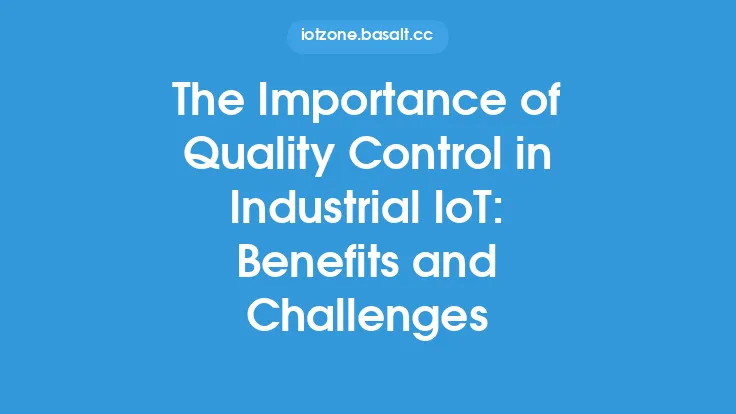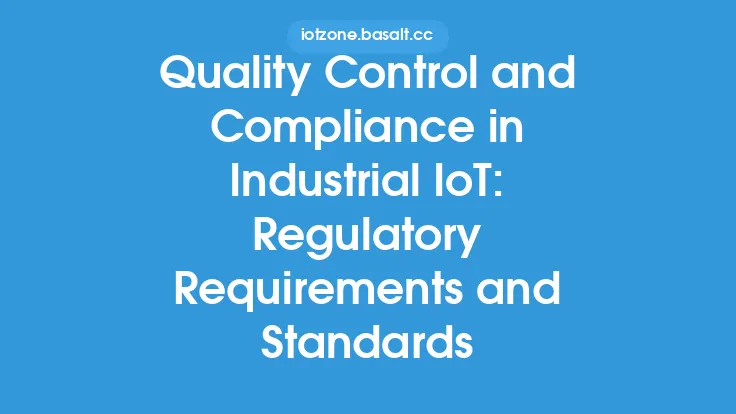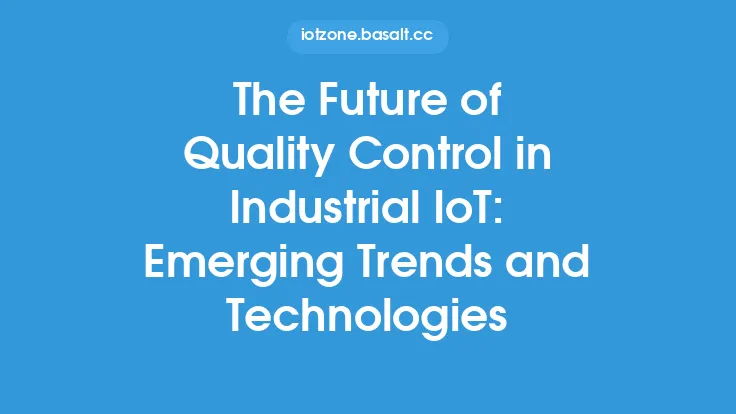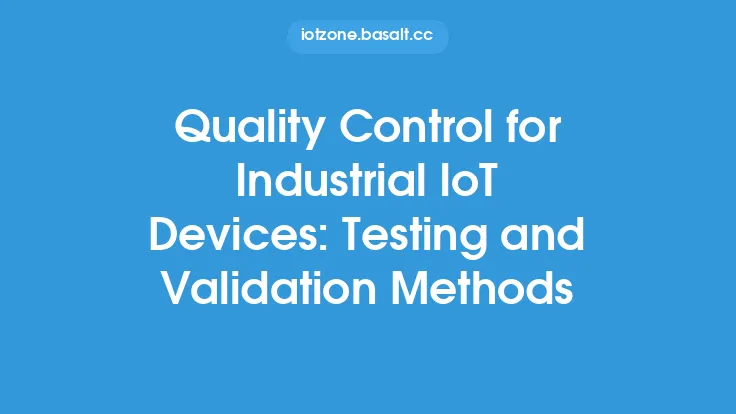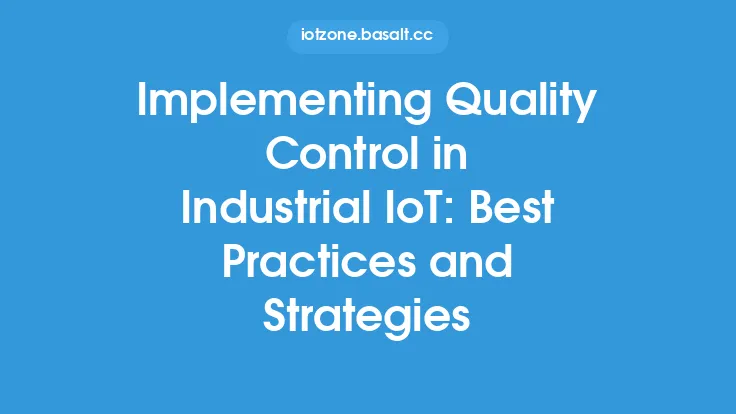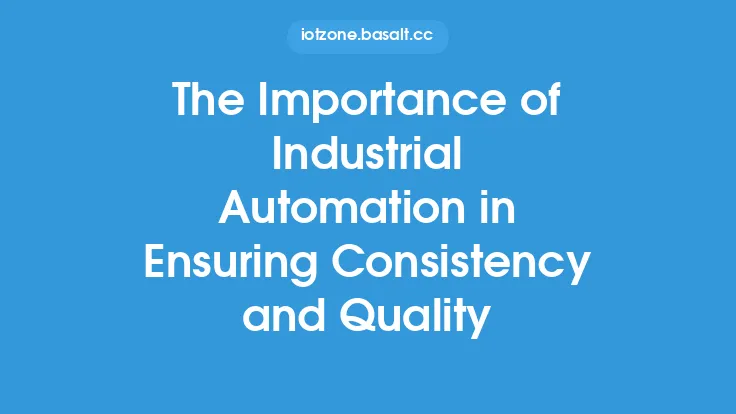The Industrial Internet of Things (IIoT) has revolutionized the way industries operate, with a vast array of devices and systems interconnected to enhance efficiency, productivity, and decision-making. However, this increased complexity also introduces new challenges, particularly in ensuring the quality and standardization of these interconnected systems. Quality control and standardization are crucial aspects of IIoT, as they enable seamless interoperability between devices and systems, ensuring that data is accurate, reliable, and consistent.
Introduction to Quality Control and Standardization
Quality control and standardization in IIoT involve a set of processes and protocols designed to ensure that devices, systems, and data meet specific requirements and specifications. This includes standards for communication protocols, data formats, and device interoperability, as well as quality control measures to detect and correct errors, defects, or inconsistencies. Standardization enables devices from different manufacturers to communicate and interact seamlessly, while quality control ensures that the data and information exchanged are accurate and reliable.
Importance of Interoperability in IIoT
Interoperability is a critical aspect of IIoT, as it enables devices and systems from different manufacturers to communicate and interact seamlessly. This is particularly important in industrial settings, where devices and systems from different vendors are often used together to achieve specific goals. Interoperability ensures that data is exchanged correctly, and that devices can work together to achieve common objectives. Without interoperability, IIoT systems would be limited to devices and systems from a single manufacturer, reducing their flexibility and effectiveness.
Standards and Protocols for IIoT
Several standards and protocols have been developed to ensure interoperability in IIoT, including communication protocols such as MQTT, CoAP, and HTTP, as well as data formats like JSON and XML. These standards and protocols provide a common language and framework for devices and systems to communicate and exchange data. Additionally, standards organizations like the Industrial Internet Consortium (IIC) and the International Electrotechnical Commission (IEC) have developed guidelines and specifications for IIoT devices and systems, ensuring that they meet specific requirements for interoperability, security, and performance.
Quality Control Measures for IIoT
Quality control measures are essential to ensure that IIoT devices and systems meet specific requirements and specifications. This includes testing and validation procedures to detect and correct errors, defects, or inconsistencies. Quality control measures also involve monitoring and analyzing data to detect anomalies or trends that may indicate problems or issues. Additionally, quality control involves implementing corrective actions to address defects or issues, as well as continuous improvement processes to enhance the overall quality and performance of IIoT devices and systems.
Device Certification and Testing
Device certification and testing are critical aspects of quality control in IIoT. Certification programs, such as those offered by the IIC and the IEC, provide a framework for testing and validating IIoT devices to ensure that they meet specific requirements for interoperability, security, and performance. Testing involves verifying that devices meet specific standards and specifications, as well as evaluating their performance under various conditions. Certification provides assurance that devices have been tested and validated to meet specific requirements, reducing the risk of errors, defects, or inconsistencies.
Data Quality and Integrity
Data quality and integrity are essential aspects of IIoT, as they ensure that the data exchanged between devices and systems is accurate, reliable, and consistent. Data quality involves ensuring that data is correct, complete, and consistent, while data integrity involves ensuring that data is not modified or tampered with during transmission or storage. Data quality and integrity are critical in IIoT, as they enable informed decision-making and ensure that devices and systems operate correctly and efficiently.
Standardization of Data Formats
Standardization of data formats is critical in IIoT, as it enables devices and systems to exchange data seamlessly. Standard data formats, such as JSON and XML, provide a common framework for representing and exchanging data, ensuring that devices and systems can understand and interpret the data correctly. Standardization of data formats also enables data analytics and machine learning algorithms to process and analyze data from different devices and systems, providing valuable insights and trends.
Implementation of Quality Control and Standardization
Implementing quality control and standardization in IIoT requires a comprehensive approach that involves multiple stakeholders, including device manufacturers, system integrators, and end-users. This involves developing and implementing standards and protocols for communication, data formats, and device interoperability, as well as quality control measures to detect and correct errors, defects, or inconsistencies. Implementation also involves testing and validation procedures to ensure that devices and systems meet specific requirements, as well as certification programs to provide assurance that devices have been tested and validated to meet specific requirements.
Benefits of Quality Control and Standardization
The benefits of quality control and standardization in IIoT are numerous, including enhanced interoperability, improved data quality and integrity, and increased efficiency and productivity. Standardization enables devices and systems from different manufacturers to communicate and interact seamlessly, while quality control ensures that data is accurate, reliable, and consistent. Additionally, quality control and standardization enable informed decision-making, reduce the risk of errors, defects, or inconsistencies, and improve overall system performance and reliability.
Challenges and Limitations
Despite the benefits of quality control and standardization in IIoT, there are several challenges and limitations that need to be addressed. These include the complexity of IIoT systems, the lack of standardization in certain industries or applications, and the need for continuous testing and validation to ensure that devices and systems meet specific requirements. Additionally, the rapid evolution of IIoT technologies and standards requires ongoing effort and investment to ensure that devices and systems remain compatible and interoperable.
Conclusion
Quality control and standardization are essential aspects of IIoT, enabling seamless interoperability between devices and systems, ensuring data quality and integrity, and improving overall system performance and reliability. By implementing standards and protocols for communication, data formats, and device interoperability, as well as quality control measures to detect and correct errors, defects, or inconsistencies, industries can ensure that their IIoT systems operate efficiently and effectively. As IIoT continues to evolve and expand, the importance of quality control and standardization will only continue to grow, enabling industries to unlock the full potential of IIoT and achieve greater efficiency, productivity, and innovation.
